

Coaxial cables are types of cables with inner conductors. These conductors are covered with a layer of insulation, and are surrounded by conductive shielding as well as an outer jacket. Electric signals flow through the center conductor. These types of cables have been used since the early 20th century by telephone companies, internet providers and many other industries. Coax cables offer accurate, reliable signal transmissions.
Coaxial cables are often included in a router, signal booster, antenna or other electronics purchase. If you purchase an antenna or amplifier that does not include coaxial cabling, however, you may be confused about which cables you should purchase that will be compatible with your device and its application. You may also have coax cable questions about specific performance, such as how much loss you'll have, as well as what kind of connectors or adapters you might need.
There are a variety of different coaxial cable types, from the traditional RG6 cable (that most people are familiar with) to thick ultra-low-loss cables used in many amplifier systems. Unfortunately, these types of coaxial cables are NOT interchangeable and can be the source of much confusion.
This page contains information about the most common coax cable types used with 4G or LTE, 5G antennas, TVs and amplifiers. It also includes what electronics equipment is typically used with each coaxial cable type, how much loss you'll incur when using the cable, the cable's diameter and "thickness" as well as the type of connectors usually found on the cable’s ends.
Be aware that cable loss is a very big deal. Most cellular antennas provide limited signal gains of 4dB to 5dB. When selecting a cable type, make sure your gains will be maximized by selecting the correct cable to improve your signal to the booster or cellular modem. This will ensure that your signal’s performance is optimized, and that and your device will work as intended.
If you have further questions about cables, including what kind of cable is needed for your usage needs or other technical specifics, don’t hesitate to reach out to us at the 5Gstore. We can help demystify coax cable types and help you determine which one will perform the best for your unique needs. We have a huge range of coaxial cable styles and lengths in stock and are ready to ship to you fast. Options are available from the top brands in the coax cable industry, including SureCall, Wilson Electronics, and others. Keep reading to learn more about the common coaxial cable types available at 5Gstore and let us help you find what kind of coax cable is right for you.
| Type | Usage | Signal Loss1 | Diameter | Connectors2 |
| RG174 50ohms 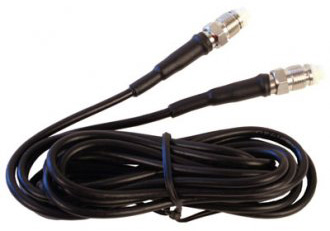 |
RG174 cable is very thin and flexible but high loss; the short lengths of cable that come pre-attached to indoor/portable antennas are RG174. Antenna adapter cables (aka "pigtails") are also made out of RG174 cable. | 3.3dB at 10ft (not suggested for longer runs) |
1/8in 3.2mm |
Typically pre-attached to an antenna and terminated in FME/Female or SMA/Male; antenna adapter cables are terminated in FME/Male. |
| RG58 50ohms 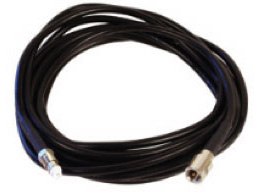 |
RG58 cable is found pre-attached to some antennas; it's also available in 2', 5', 10', 15', and 20' lengths to be used with antennas/amplifiers that don't include cabling or as extensions to the pre-attached cable on antennas. It's considerably more flexible than LMR240, making it a popular choice for running under window seals, around corners, etc. | 2dB at 10ft 3.75dB at 20ft (not suggested for longer runs) |
3/16in 4.77mm |
When pre-attached to an antenna it is usually terminated in FME/Female; standalone RG58 cables may have either N, FME, or SMA connectors. |
|
Low Loss 195 50 ohms
|
Low Loss 195 is an excellent replacement for RG-58 cables. Low Loss 195 is designed for antenna feeder jumper assemblies and other runs that demand a high-performance, flexible, and low-loss RF cable. |
1.1dB over 10ft, 2.2dB at 20ft, 5.5dB at 50ft (not suggested for longer runs) |
1/5in 4.95mm |
Low Loss 195 is typically used in RF (radio frequency) applications where signal strength and low loss over short to moderate distances are essential. Its primary applications include: WiFi systems, GPS systems, and Cellular boosters or antennas. Cables may have either N, FME, or SMA connectors. |
| LMR240 50ohms 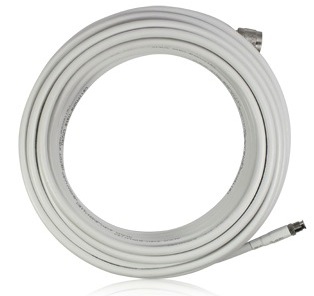 |
LMR240 cable is available in 10', 20', 25', and 40' lengths to be used with antennas/amplifiers that don't include cabling or as extensions to the pre-attached cable on antennas. It's stiffer and less flexible than RG58, but has less loss. | 1dB at 10ft 1.9dB at 20ft 3.9dB at 40ft (not suggested for longer runs) |
1/4in 6.35mm |
Either N/Male or FME/Male on one end and FME/Female on the other. |
| LMR400 50ohms 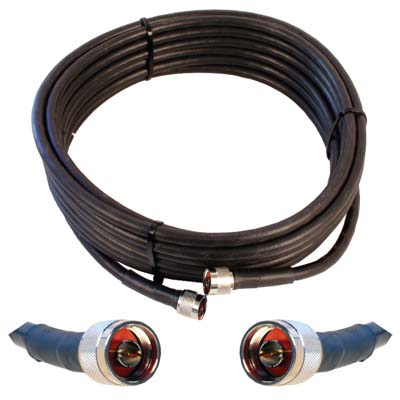 |
LMR400 cable has very little loss, but is much thicker and less flexible than RG58 or LMR240 cable, making it harder to work with. It's available in various lengths from 2' to 100' to be used with antennas/amplifiers that don't include cabling. | 1dB at 20ft 2.5dB at 50ft 5dB at 100ft |
7/16in 11.1 MM |
Varies - often N/Male on both sides, or SMA/Male and SMA/Female, or N/Male and SMA/Male |
| LMR600 50ohms  |
LMR600 cable has limited loss, thicker and less flexible than LMR400 cable, making it harder to work with. It's available in various lengths from 100ft to 300ft to be used with antennas/amplifiers that don't include cabling. |
2.18dB at 100ft 4.36dB at 200ft 6.54dB at 300ft |
3/5in 15mm |
N/Male |
| RG6 75ohms 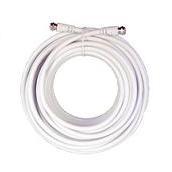 |
RG6 is most commonly used in cable/satellite TV installations and is NOT usually used with cellular antennas or amplifiers (there are a few 75ohm amplifiers, like the Wilson DB Pro and AG Pro 801265, as well as some from other manufacturers). We do NOT recommend using RG6 cable with 50ohm antennas and amplifiers - it has significantly more loss than LMR240 or LMR400 cable AND you will need additional adapters to connect everything, which results in even more signal loss. | 2.3dB at 20ft 3.5dB at 30ft 5.9dB at 50ft |
5/16in 7.9mm |
F/Male |
Notes:
The amount of signal attenuation you'll see depends on which frequency you're using. There is more signal loss on higher frequencies (such as some Canadian carriers who use the 2500MHz band, or Wi-Fi, which is on the 2500MHz band) than there is on the lower frequencies (such as Verizon/AT&T LTE, which operate on the 700MHz frequency).
Remember that you lose about 0.5dB at every connection. Chaining multiple cables together (referred to as "daisy-chaining") is not recommended. It often makes more sense to choose a cable with the appropriate connectors for your needs than to use a lower-loss cable that will require additional connectors to connect it to your equipment. For example, you would have less loss using a 20' LMR240 cable that has the correct connectors on it than you would have if you used a 20' LMR400 cable plus adapters on each end, even though the LMR400 cable has less loss than the LMR240.
The connectors listed here are those found on the cables sold at 5Gstore and most other places. However, cables sold elsewhere may be terminated differently. Always double-check connector types when buying components piecemeal. If you're not sure what type of connector is required for your existing equipment, check out our Connectors Reference Guide. Or, if you have further questions and want to make sure you purchase the correct coaxial cable type for your specific application and usage scenario, you can always reach out to 5Gstore. Our experts are here to help you order your coax cable confidently. Call us toll-free during business hours, or fill out the contact request form on our Contact Us page.